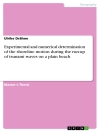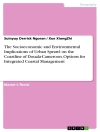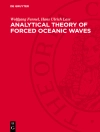This book provides holistic case studies of technology development, examples of its complexities and an in-depth analysis from the perspective of information infrastructure. Natural disasters such as cyclones, tsunamis, earthquakes and volcanoes have disrupted the lives of people all over the world, particularly in Asia. In order to manage disasters and mitigate the damage, many technologies—surveillance systems, for instance—have been developed. An example of natural disaster is the ongoing devastation caused by COVID-19, which highlights the multi-disciplinary nature of disaster management, including agriculture, healthcare, economics, environment, engineering and technology. The pandemic has also led to the development and uptake of technologies such as vaccine development, new biotechnological innovations, telemedicine, the Internet of things (Io T) and mobile health (m Health) all over the world. The United Nations Sustainable Development Goals (SDGs) programme suggests an integrated approach to their development. For example, healthcare needs to be addressed in holistic perspectives including education, environment, economy and regulations, among others.
These goals create challenges in the development, validation and deployment of new technology, with this book presenting a discussion of innovations in sustainable development of healthcare in the multi-disciplinary context of SDGs.
Inhaltsverzeichnis
Technology innovation for sustainable healthcare and disaster Management.- The Role of Social media in Disaster management:Opportunities, Challenges, and Future Directions.- Technology Innovations for Disaster Management in Developing Countries-Case Study for the Indian Ocean Tsunami at Banda Aceh, Indonesia.- Design and Development of the Medical Fuel Cell Vehicle-The technology links Mitigation and Adaptation in Climate Change.- Technologies for Disaster Management: Case Studies in the Past Tsunami in Japan.- Emerging Technologies to avoid preventable death in emergencies: A Case study on Hypothermia Prevention in a refugee centre in winter.- Techniques and process development for quick response and sustainable Recovery.- Towards a housing design that can withstand natural disasters: A Study in Sundarbans.- Innovative Sanitation System for Disaster Victims and Social Sanitation Challenges.- Benefits and Barriers of Using Whats App In Eye Health Communication in Deprived Settings in India.- Applications of Drones in Disaster Response.- A Generic Model to Capture Essential Information on Limited Capacity Mobile Devices during a Disaster.- Intelligent eye tracking for the early diagnosis of autism: A Mental Health Disaster with families.- Avoiding Health Disasters using Blockchain Technology: A Plastic Surgery Perspective.- Healthcare 4.0 (and 5.0): Digitising Health and Care.- Digital Twin Model based Portable Neuroimaging Analysis for Home-based Interventions in Type 2 Diabetes.
Über den Autor
Prof Pradeep Ray is the founder of the Centre For Entrepreneurship (CFE) at the University of Michigan-Shanghai Jiao Tong University Joint Institute since 2017. He is a Fellow of IET. He established the research theme of Technology Entrepreneurship for Sustainable Development that led to the recent book “Technology Entrepreneurship and Sustainable Development” by Springer Nature (eds Pradeep Ray and Rajib Shaw), Singapore in 2022. He has also been an Honorary Professor in the UNSW Medicine and Health in Australia since 2016. Prior to 2016, he established and led for 10 years from 2006 the Asia-Pacific ubiquitous Healthcare research Centre (APu HC) that was designated as the WHO Collaborating Centre (WHOCC) on e Health at UNSW in 2013. Pradeep was a Professor and the Director of this WHOCC from 2013-2016 and led many projects on e Health including those involving disaster management with collaborations across several countries (Bangladesh, India, Indonesia, China, Japan, EU etc.). He founded IEEE Healthcom (e Health Networking, Applications and Services Conference) in 1999. In his current role in China, he has been leading multi-country projects, such as m Health for Belt and Road Region (2018-2020) leading to a book including a Section on m Health for disasters with 4 chapters led by Dr. Soshino and Dr. Geumpana “Mobile Technologies for Delivering Healthcare in Remote, Rural or Developing Regions”, published by IET Press, London in 2020.
Rajib Shaw is a professor in Graduate School of Media and Governance of Keio University, Japan. He is co-founder of a Delhi based social entrepreneur startup, Resilience Innovation Knowledge Academy (RIKA), and chair of the board of two Japanese non-government agencies: SEEDS Asia and CWS Japan. He is the Co-chair of the United Nations Office for Disaster Risk Reduction (UNDRR) Asia Pacific Science Technology Advisory Group (AP-STAG), and CLA for IPCC’s 6th Assessment Report. Professor Shaw has 67 books and more than 400 research papers in the field of environment, disaster management and climate change. He is the editor in chief of Progress in Disaster Science. Professor Shaw is the recipient of “Pravasi Bharatiya Samman Award (PBSA)” in 2021 for his contribution in education sector. PBSA is the highest honor conferred on overseas Indian and person of Indian origin from the President of India. He also received United Nations Sasakawa Award in 2022 for his lifetime contributions in the field of disaster risk reduction.
Dr. Yasuhiro Soshino is the head of the Humanitarian Technology unit at the Disaster Management Research Institute in the Japanese Red Cross College of Nursing and currently leads the world’s first hydrogen ambulance project with Toyota Motor Corporation. Dr. Soshino has headed various projects on humanitarian technologies for disaster management, with a focus on supporting the self-help efforts of disaster-affected people by using mobile technologies. His five inventions for motivating people toward their evacuation have been patented in Japan, the US, China and EU countries. Dr. Soshino also created the evacuation support system using Mobility as a Service (Maa S) technology, which was patented in 2019. He is a member of the Field Assessment and Coordination Team (FACT) of the International Federation of Red Cross and Red Crescent Societies (IFRC).
Dr. Anirban Dutta received his Ph.D. in biomedical engineering from Case Western Reserve University, USA, in 2009. After postdoctoral experiences at Howard Hughes Medical Institute, then the Rehabilitation Institute of Chicago in the USA, at Universitätsmedizin Göttingen, Germany, he started his independent researcher career in 2012 at the National Institute for Research in Digital Science and Technology (INRIA), France, as a research scientist launching Neuro Phys4Neuro Rehab project. He joined the University at Buffalo, USA, as a tenure-track assistant professor in 2016, then, moved to the University of Lincoln, UK, as an associate professor and the programme leader of biomedical engineering in 2022 and is currently at the University of Birmingham, UK, as an associate professor of quantitative biomedicine.
Dr. Teuku Geumpana is a computing and IT lecturer at the School of Information and Physical Sciences at the University of Newcastle (UON), Australia. Dr. Geumpana has a strong interest in promoting the utilisation of information technology in disaster management response via research and education. He has published several book chapters, journal articles and conference proceedings about implementing information technology in disaster management response. During his Ph.D. work at the University of New South Wales (UNSW), he was an affiliated graduate researcher at the Asia-Pacific Ubiquitous Healthcare Research Centre (APu HC) and Data61 of the Commonwealth Scientific and Industrial Research Organisation (CSIRO). Earlier, Dr. Geumpana took part in the emergency response to Indonesia’s 2004 Indian Ocean Tsunami and Earthquake as a technologist and IT specialist.












